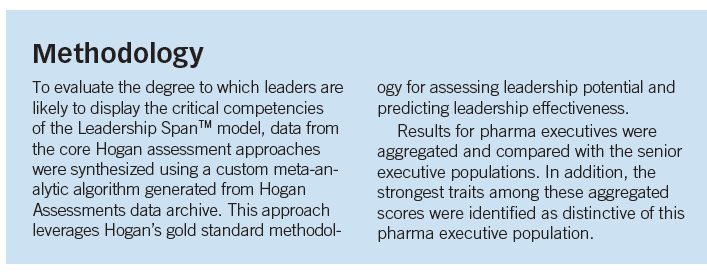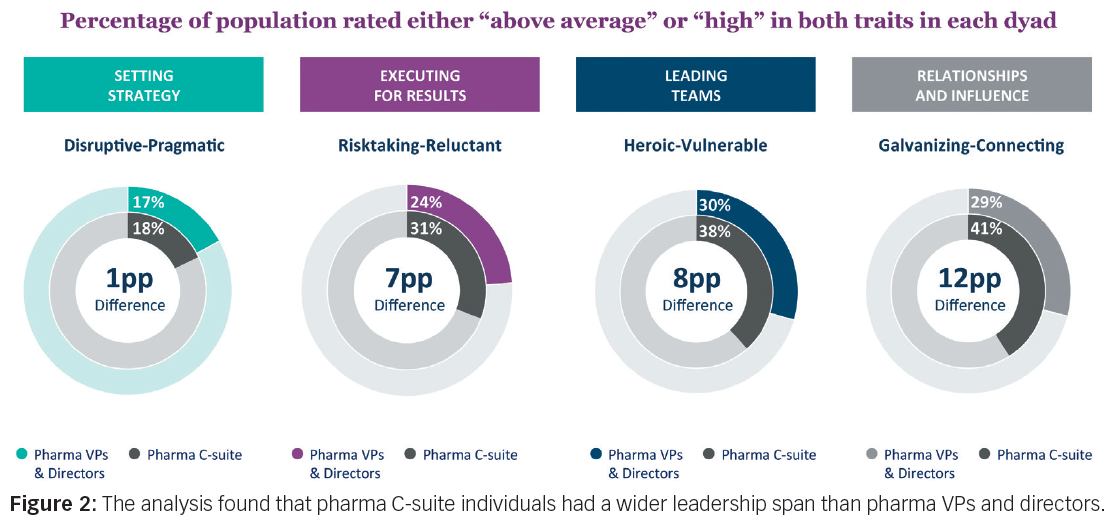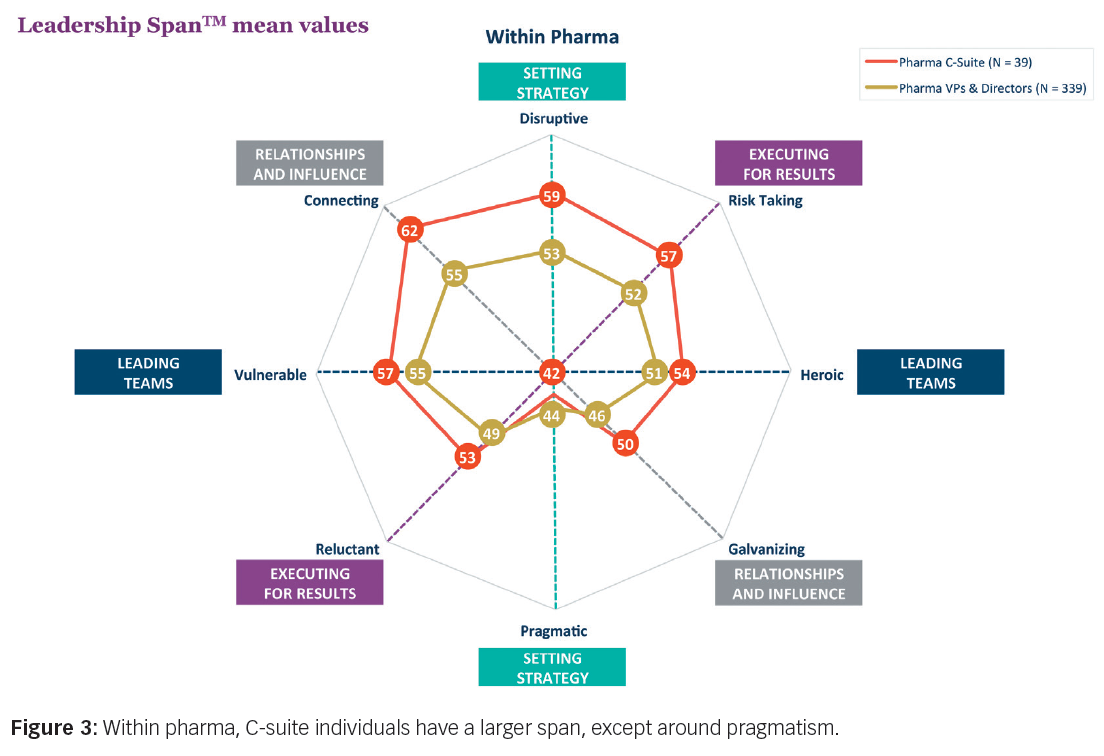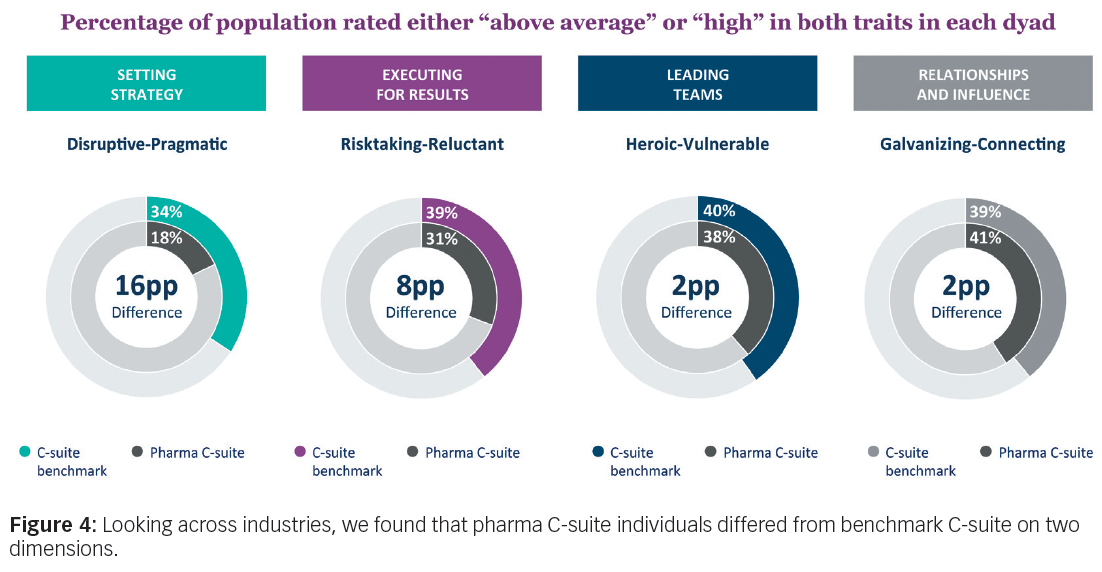C-Suite Personality: Fit for Future?
Pharmaceutical Executive
Exploring new character benchmarks for today’s pharma executives, and whether they have the transformational traits to lead through change.
Exploring new character benchmarks for today’s pharma executives, and whether they have the transformational traits to lead through change
Leadership’s importance to organizational success is clear. Effective leadership focuses companies around strategy and inspires staff toward goals. Whereas, wrong-headed leadership destroys confidence and hinders an organization’s ability to adapt to change. It is also clear that today’s complex and volatile business environment has dramatically changed the leadership qualities required in the C-suite.
Two leadership topics, however, require more nuanced answers:
- What are the traits that effective and adaptive leaders need in order to lead through change and uncertainty?
- How suited are the personalities of pharma executives to navigating organizations through transformation?
This article describes a new perspective on the character profile of effective C-suite leadership across industries, and benchmarks the specific profile of executive leaders in the pharmaceutical industry.
The challenge of assessing leadership capacity
The last two decades have seen a doubling in annual spending on leadership assessment and development. However, the same time period has been marked by a sharp decline in confidence in leadership assessment. The shortcomings of old leadership assessment methods lie in two major categories. First, they tend to be rather general and not tailored around the unique profiles of C-level positions. Second, old methods are myopic. They may do a fairly good job of selecting leaders able to meet the current demands of an organization and its market, but they are less successful in selecting those able to grow and adapt to the inevitable and rapid changes.
A part of this shortsightedness may be an overinvestment in certain leadership approaches. Specifically, a set of “loud” traits -the competencies that get noticed, such as tough-mindedness and decisiveness-are widely believed to be not just fundamental to but sufficient for successful leadership. When hiring, however, board members and senior leaders should be mindful that when “loudness” is the entirety of an executive’s personality profile, it threatens the long-term success known as “C-suite durability.”
A unique approach to predicting durable C-suite success
Research on thousands of successful C-suite executives makes it clear that successful executives are much more than a collection of “loud” traits. The capacity to be bold and decisive is certainly critical to effective leadership, but equally necessary is a set of “quiet” attributes-the subtle competencies, like emotional sensitivity and humility.
When “loud” traits are present in abundance but “quiet” characteristics are in short supply, two situations emerge that can lead to an executive’s derailment: a) The executive is unable to cope with the new requirements of changing business conditions, or b) The executive’s “overuse” of traits once seen as strengths goes unchecked.
It is the combination of both loud and quiet leadership competencies that helps ensure a C-suite executive’s long-term effectiveness and impact.
Collaborative research between Russell Reynolds Associates and Hogan Assessment Systems has yielded
Click to enlarge

Leadership SpanTM-a forward-focused, tailored, and dynamic approach to identifying the traits of C-level executives who experience long-term success (see methodology explainer at left). The research identified successful leadership qualities by looking at executive job performance through the lens of over 400 criterion studies and analyzing a data set of 32,000 executives that matched performance data to assessment data. From this, a set of personality dimensions that best predict performance was derived, creating the basis of the framework.
When it comes to the characteristics of executives along four dimensions of C-suite responsibilities, balance, per se, is not the key. It is not the “happy middle ground” between two opposing personality styles that is at the heart of successful leadership, but rather very pronounced leanings toward both competing competencies (see Figure 1).

Leadership SpanTM recognizes that an organization’s internal and external environments are not static. The approach to Setting Strategy, for example, will inevitably require a leader who is highly inclined to be measured and pragmatic, with an equally strong pull toward being bold and disruptive. When these “competing competencies” are clearly embodied in a single executive, organizations are better able to adapt to the constantly evolving situations of dynamic markets.
Along four dimensions, successful leaders are highly and simultaneously:
- Pragmatic and disruptive. In Setting Strategy, leadership should bring a level of innovation that shakes up the status quo when necessary as well as a pragmatism that is conducive to focus, priority setting, and a healthy pace of change.
- Reluctant and risk-taking. In Executing for Results, calculated risk and measured optimism are hallmarks of strong leadership. Leaders should be just as inclined toward strategic hesitation as they are toward bold action.
- Vulnerable and heroic. In Leading Teams, perseverance and grit are only useful traits insofar as they don’t make executives immune to criticism or cause them to deny reality. Leaders need to be open to feedback and external data and adjust accordingly.
- Connecting and galvanizing. In Relationships and Influence, leaders must be able to rally the organization behind their ideas, but they also need to know when to empower and give credit to others and how to connect the organization in ways that make it greater than an individual personality.
The degree to which these paradoxical traits are embodied in a single leader is the “span”-the higher an individual scores in both “competing” traits along one of the four dimensions, the bigger the span in that dimension. An analysis of various levels of leadership shows that the size of the span increases as the level of leadership responsibility grows. For example, C-suite leaders exhibit a significantly wider span than global executives, whose span is wider than those of mid-level managers.
Demystifying the personalities of pharma C-suite leadership
Across industries, the correlation between span and leadership level is quite clear, but what does this phenomenon look like for pharmaceutical executives in particular? To explore this question, Russell Reynolds used industry-wide data as a benchmark and then compared pharma-specific results in the following two ways.
C-suite pharma executives vs. other pharma leaders
Across industries, C-suite leaders possess a larger span than other professionals do. That is, leaders at the highest levels score higher in both competing traits along all four dimensions than lower- and mid-level professionals. Our research finds that this is true in pharma as well, but with one exception. On the Setting Strategy dimension, the span for C-suite executives is not significantly different than it is for pharma VPs and directors (see Figure 2).

We measured individuals in two groups-pharma C-suite and pharma VPs/directors-on the competing characteristics within each of the four dimensions. We then looked at who was rated either “above average” or “high” for both characteristics within each dimension. For example, along the dimension of Executing for Results, about 24% of VPs and directors in pharma rated above average or high in terms of risk-taking and reluctance. Whereas, 31% of C-suite executives scored well on these traits. For the dimensions of Leading Teams and Relationships and Influence, there, C-suite executives score higher than other leaders in pharma organizations as well. It is only in the Setting Strategy dimension that the two groups score about the same.
A closer look at scores for the individual characteristics within each dimension is revealing. In Figure 3 below, we have mapped out each of the dimensions as an axis on a spider chart. The competing traits are mapped on opposite ends of the line. An individual with a larger span across the dimensions will have a larger circle.

Looking at the results, we see that in general, C-suite executives in pharma have a larger span than VPs and directors, in that the red circle is larger than the yellow one. Surprisingly though, we see that scores for one characteristic within Setting Strategy depart from the pattern and lead to the two cohorts having similar spans in that dimension. While pharma C-suite executives are more “disruptive” than their more junior colleagues, they score about the same in measurements of how “pragmatic” they are.
We will return to why we believe this effect is happening after the second cohort comparison.
C-suite pharma vs. C-suite benchmark
Examining the data to compare C-suite executives in pharma to their counterparts across other industries further emphasizes pharma’s uniqueness. In this analysis, it is also the Setting Strategy personality dimension that is the source of the difference, with C-suite leaders in pharma having a narrower span along this dimension than the benchmark group of C-suite executives (see Figure 4).

Although pharma C-suite executives are similar to other industry C-suite leaders along the other three dimensions, there is a significant difference along the first dimension of Setting Strategy. Once again, if we look specifically at the two traits of this dimension, we find that pragmatism is the culprit, with C-suite executives in pharma scoring just as high on the “disruptive” trait as their counterparts in other industries, but being significantly less “pragmatic” (see Figure 5).

In a nutshell, pharma C-suite executives tend to be less pragmatic than C-suite executives in other industries, and unlike their counterparts in other sectors, they are not more pragmatic than their VPs and directors. In addition, the C-suite seems to be selecting and grooming directors and VPs with similar traits, as is evidenced by “pragmatism” being the characteristic in which pharma’s junior leaders also score the lowest.
As pressure builds, pragmatic leadership becomes more important
To examine the “span gap” in pharma, it is important to understand the industry’s historical context. Pharma has enjoyed traditionally high margins, and as an industry it has been relatively safe from some of the market pressures faced by, for example, electronics or consumer goods. Specifically, pharma’s 15-year development timelines and 20-year post-invention patent protections have created a rather protected
Sidebar: A Tale of Two Leaders; click to enlarge

commercial model with high hurdles to entry. Given pharma’s level of immunity to market threats thus far, it makes sense that pragmatism may not be fostered as an important trait in a C-suite executive.
Looking ahead, however, pharma’s commercial model may not continue to enjoy protections, and pressure will likely mount. Disaggregation of the pharma value chain, regulatory compliance, digitization, and value-based reimbursement models are among the trends that are making management issues less static. As pressure grows, pragmatism will become an increasingly important trait of the C-suite pharma executive, and leaders will need to be chosen who demonstrate strength in this trait as well as in the seven others.


Waseem Noor is a Consultant at Russell Reynolds Associates. He can be reached at waseem.noor@russellreynolds.com
Saule Serikova is Global Knowledge Leader for Healthcare at Russell Reynolds Associates. She can be reached at saule.serikova@russellreynolds.com
